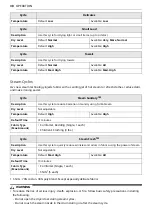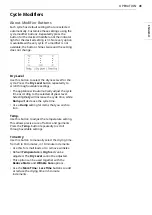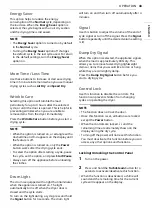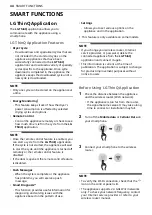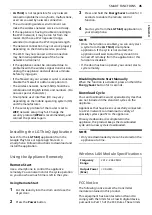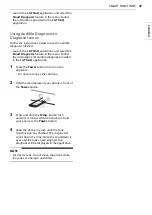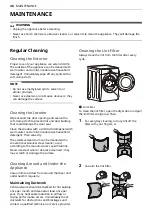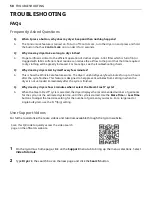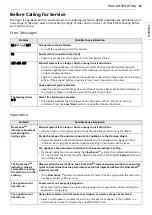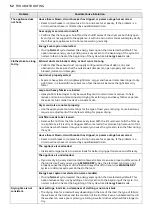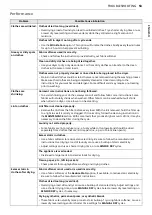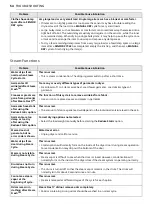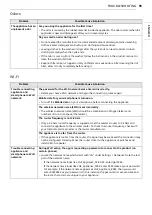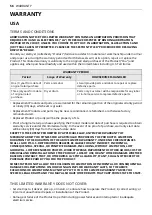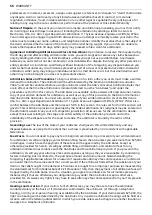
52
TROUBLESHOOTING
The appliance does
not heat.
House fuse is blown, circuit breaker has tripped, or power outage has occurred.
• Reset circuit breaker or replace fuse. Do not increase fuse capacity. If the problem is a
circuit overload, have it corrected by a qualified electrician.
Gas supply or service is turned off.
• Confirm that the hose gas shutoff and the shutoff valves of the dryer are both fully open.
Even if gas is not supplied to the appliance, it will run and no error codes will display. Verify
that other gas appliances in the home are working normally.
Energy Saver option is selected.
• If using
Normal
cycle, deselect the energy saver option that is selected by default. This
option reduces energy use by adding an air dry section to the beginning of the cycle. It is
normal to feel no heat at the beginning of the cycle while in
Energy Saver
mode.
Clothes take too long
to dry.
Exhaust ducts are blocked, dirty, or duct run is too long.
• Confirm that the exhaust duct is properly configured and free of debris, lint, and
obstructions. Make sure that the outside wall damper can open properly and are not
blocked, jammed, or damaged.
Load is not properly sorted.
• Separate heavy items from lightweight items. Larger and heavier items take longer to dry.
Light items in a load with heavy items can fool the sensor because the light items dry
faster.
Large and heavy fabrics are loaded.
• Heavy fabrics take longer to dry because they tend to retain more moisture. To help
reduce and maintain more consistent drying times for large and heavy fabrics, separate
these items into smaller loads of a consistent size.
Dryer controls are not set properly.
• Use the appropriate control settings for the type of load you are drying. Some loads may
require an adjustment of the dry level setting for proper drying.
Lint filter needs to be cleaned.
• Remove the lint from the filter before every load. With the lint removed, hold the filter up
to a light to see if it is dirty or clogged. With some loads that produce high amounts of lint,
such as new bath towels, it may be necessary to pause the cycle and clean the filter during
the cycle.
House fuse is blown, circuit breaker has tripped, or power outage has occurred.
• Reset circuit breaker or replace fuse. Do not increase fuse capacity. If the problem is a
circuit overload, have it corrected by a qualified electrician.
The appliance is overloaded.
• Divide extra large loads into smaller loads for better drying performance and efficiency.
The appliance is underloaded.
• If you are drying a very small load, add a few extra items to ensure proper tumble action. If
the load is small and you are using
SENSOR DRY
cycles, the electronic control can not
properly sense the dryness of the load and may shut off too soon. Use
MANUAL DRY
cycles or add some extra wet clothes to the load.
Energy Saver option is selected. (on some models)
• If using
Normal
cycle, deselect the energy saver option that is selected by default. This
option reduces enery use by adding an air dry section to the beginning of the cycle. It is
normal to feel no heat at the beginning of the cycle while in
Energy Saver
mode.
Drying time is not
consistent.
Heat settings, load size, or dampness of clothing is not consistent.
• The drying time for a load will vary depending on the size of the load, the type of fabrics,
the wetness of the clothes and the condition of the lint filter. Even an unbalanced load in
the washer can cause poor spinning, resulting in wetter clothes which will take longer to
dry.
Problem
Possible Cause & Solution
Содержание DLEX89 0 Series
Страница 60: ...60 Memo ...
Страница 61: ...61 Memo ...
Страница 62: ...62 Memo ...
Страница 63: ...63 Memo ...

